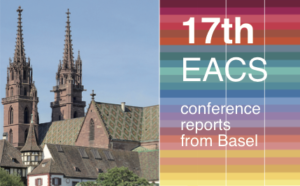Long-acting cabotegravir and rilpivirine: similar results in women and men
24 February 2020. Related: Conference reports, Antiretrovirals, Women's health, EACS 17 Basel 2019.
A pooled analysis of two phase 3 trials of monthly long acting cabotegravir and rilpivirine (CAB + RPV LA) found similar efficacy among women and men at 48 weeks. [1]
There were also no significant differences between women and men in adverse events (AEs), injection site pain or study withdrawals. And treatment satisfaction was higher among women in the CAB + RPV LA arm vs control.
Romina Quercia from ViiV Healthcare presented these results at EACS 2019 from an analysis of efficacy, safety and patient satisfaction among women participants in the ATLAS and FLAIR trials.
ATLAS and FLAIR are randomised (1:1), international, open label studies that demonstrated non-inferiority of switching to monthly intramuscular (IM) injections of CAB + RPV LA vs current antiretroviral regimen.
ATLAS enrolled ART-experienced participants on stable ART (two NRTIs and a third agent). FLAIR participants were ART-naive and the study included a 20-week induction phase with dolutegravir/abacavir/lamivudine oral fixed dose combination.
At randomisation, participants in the CAB + RPV LA arms in both studies received oral CAB + RPV for four weeks before receiving IM injections.
Both studies were designed with enrolment targets for women: ATLAS at least one in four and FLAIR one in five participants.
Pooled subgroup analysis by sex at birth was pre-planned and based on week 48 primary endpoint of viral load >50 copies/mL and secondary endpoint of <50 copies/mL.
Across the two trials there were 27% (162/591) women in the CAB + RPV LA arms and 28% (168/591) in the control arms.
At baseline, 28% of women had BMI >30 kg/m2 compared with 13% of men. Almost 40% of women were black or African American compared with just below 15% of men.
At week 48, 3.1% and 0.6% of women in CAB + RPV LA and control arms had viral load >50 copies/mL. These proportions were similar for men, respectively 1.4% and 2.1%. Suppression rates were also similar between women and men.
Seven confirmed virological failures occurred in both arms including 5/7 and 2/7 women in the CAB/RPV LA and control arms respectively. These cases are under analysis and currently considered to be multifactorial.
There were no significant differences between women and men in AEs and injection site reactions (most grade 1 or 2 and none severe). Women reported less injection site pain than men: 66% vs 82%. Two women and four men withdrew from the studies due to injection site reactions (both approximately 1%).
Retention in the studies was high for women receiving CAB + RPV LA: 90% (overall 92%).
In a post-hoc analysis at week 44, CAB + RPV participants showed higher treatment satisfaction vs those in the control arm. This increased from baseline and was greater among women participants.
comment
The enrollment of almost 30% in these trials is laudable and considerably more than what we have come to expect in industry phase 3 trials of antiretrovirals.
One notable sex difference reported for CAB is longer half-life for women and men. CAB is still detectable after 3.5 years following a single injection in some women vs 2.5 years in some men.
In a related presentation in this session, we were reminded that about 38 million people are living with HIV of which just over 19 million are women. This proportion of 50.4% is in stark contrast to the 18.9% of women study participants in HIV clinical trials shown in a recent analysis. [2]
The investigations in the pooled analysis of CAB + RPV LA did not reveal any significant sex differences at 48 weeks. But having a larger group of women meant that this information was not based on a meaningless subgroup analysis among only a handful of participants.
Having enrolment targets for women was also associated with a more diverse population than often seen in phase 3 studies. In the pooled analysis, almost 40% of women were black or African American (compared with less than 15% of men). Less than half of the women were recruited from Western Europe or North America (compared with 75% of men) and 21% were from South Africa compared with 4% of men.
References
1. Quercia R et al. Outcomes for women in phase 3 trials of long-acting cabotegravir + rilpivirine: pooled ATLAS and FLAIR week 48 results.17th European AIDS Conference (EACS). Basel, Switzerland. 6–9 November, 2019. Oral abstract PS1/1.
http://resourcelibrary.eacs.cyim.com/?mediaId=78023(webcast)
2. Sander F et al. Are there gender and age differences in ARV PK? 17th European AIDS Conference (EACS). Basel, Switzerland. 6–9 November, 2019. Oral presentation ML1.
http://resourcelibrary.eacs.cyim.com/?mediaId=78017(webcast)


 Polly Clayden, HIV i-Base
Polly Clayden, HIV i-Base